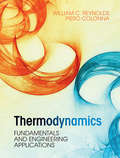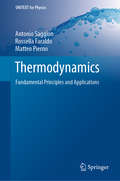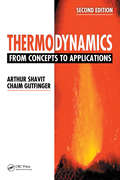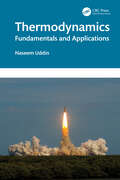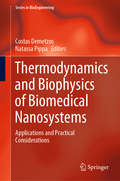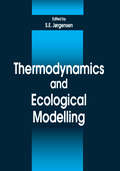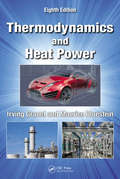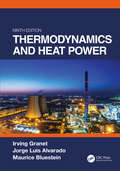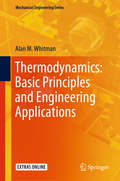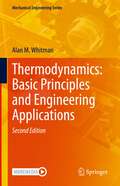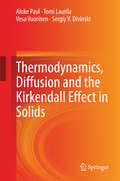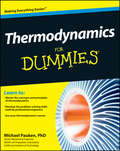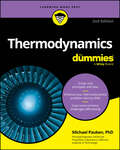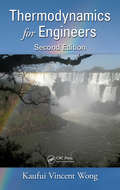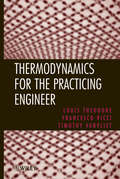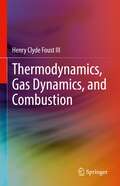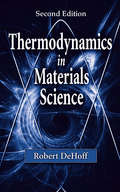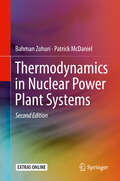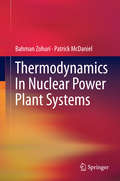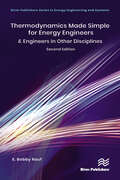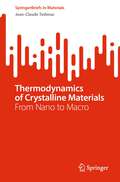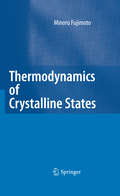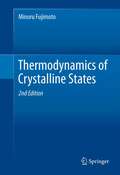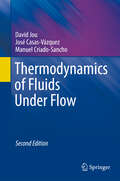- Table View
- List View
Thermodynamics: Fundamentals and Engineering Applications
by William C. Reynolds Piero ColonnaThis concise text provides an essential treatment of thermodynamics and a discussion of the basic principles built on an intuitive description of the microscopic behavior of matter. Aimed at a range of courses in mechanical and aerospace engineering, the presentation explains the foundations valid at the macroscopic level in relation to what happens at the microscopic level, relying on intuitive and visual explanations which are presented with engaging cases. With ad hoc, real-word examples related also to current and future renewable energy conversion technologies and two well-known programs used for thermodynamic calculations, FluidProp and StanJan, this text provides students with a rich and engaging learning experience.
Thermodynamics: Fundamental Principles and Applications (UNITEXT for Physics)
by Antonio Saggion Rossella Faraldo Matteo PiernoThis book offers a comprehensive overview of thermodynamics. It is divided into four parts, the first of which equips readers with a deeper understanding of the fundamental principles of thermodynamics of equilibrium states and of their evolution. The second part applies these principles to a series of generalized situations, presenting applications that are of interest both in their own right and in terms of demonstrating how thermodynamics, as a theory of principle, relates to different fields. In turn, the third part focuses on non-equilibrium configurations and the dynamics of natural processes. It discusses both discontinuous and continuous systems, highlighting the interference among non-equilibrium processes, and the nature of stationary states and of fluctuations in isolated systems. Lastly, part four introduces the relation between physics and information theory, which constitutes a new frontier in fundamental research.The book includes step-by-step exercises, with solutions, to help readers to gain a fuller understanding of the subjects, and also features a series of appendices providing useful mathematical formulae. Reflecting the content of modern university courses on thermodynamics, it is a valuable resource for students and young scientists in the fields of physics, chemistry, and engineering.
Thermodynamics: From Concepts to Applications, Second Edition
by Arthur Shavit Chaim GutfingerThere are many thermodynamics texts on the market, yet most provide a presentation that is at a level too high for those new to the field. This second edition of Thermodynamics continues to provide an accessible introduction to thermodynamics, which maintains an appropriate rigor to prepare newcomers for subsequent, more advanced topics. The book p
Thermodynamics: Fundamentals and Applications
by Naseem UddinThermodynamics: Fundamentals and Applications offers a blend of theory and practical applications for a complete understanding of thermodynamics for various engineering applications. Beginning with a basic introduction and principles of thermodynamics, the book advances to more specialized topics like organic Rankine cycle, gas mixtures, equilibria and chemical reactions.Exploring the first law of thermodynamics, different types of energies and their practical applications in engineering devices, the text covers enthalpy, heat transfer and work interactions with a focus on macroscopic and microscopic perspectives. It introduces the second law of thermodynamics and entropy with an in-depth look at Carnot engines and absolute temperature scales. The book includes applied problems that are solved using COOLPROP, Tilmedia and MAPLE-ThermophysicalData packages.The book is intended for senior undergraduate mechanical, aerospace and chemical engineering students taking courses in thermodynamics.Instructors will be able to utilize a Solutions Manual, Figure Slides, and MAPLE codes for their courses.
Thermodynamics and Biophysics of Biomedical Nanosystems: Applications and Practical Considerations (Series in BioEngineering)
by Costas Demetzos Natassa PippaThis book highlights the recent advances of thermodynamics and biophysics in drug delivery nanosystems and in biomedical nanodevices. The up-to-date book provides an in-depth knowledge of bio-inspired nanotechnological systems for pharmaceutical applications. Biophysics and thermodynamics, supported by mathematics, are the locomotive by which the drug transportation and the targeting processes will be achieved under the light of the modern pharmacotherapy. They are considered as scientific tools that promote the understanding of physicochemical and thermotropic functionality and behavior of artificial cell membranes and structures like nanoparticulate systems. Therefore, this book focusses on new aspects of biophysics and thermodynamics as important elements for evaluating biomedical nanosystems, and it correlates their physicochemical, biophysical and thermodynamical behaviour with those of a living organism.In 2018, Prof. Demetzos was honored with an award by the Order of Sciences of the Academy of Athens for his scientific contribution in Pharmaceutical Nanotechnology.
Thermodynamics and Ecological Modelling (Environmental & Ecological (Math) Modeling)
by Sven E. JorgensenThermodynamics is used increasingly in ecology to understand the system properties of ecosystems because it is a basic science that describes energy transformation from a holistic view. In the last decade, many contributions to ecosystem theory based on thermodynamics have been published, therefore an important step toward integrating these theories and encouraging a more wide spread use of them is to present them in one volume.An ecosystem consists of interdependent living organisms that are also interdependent with their environment, all of which are involved in a constant transfer of energy and mass within a general state of equilibrium or dis-equilibrium. Thermodynamics can quantify exactly how "organized" or "disorganized" a system is - an extremely useful to know when trying to understand how a dynamic ecosystem is behaving.A part of the Environmental and Ecological (Math) Modeling series, Thermodynamics and Ecology is a book-length study - the first of its kind - of the current thinking on how an ecosystem can be explained and predicted in terms of its thermodynamical behavior. After the introductory chapters on the fundamentals of thermodynamics, the book explains how thermodynamic theory can be specifically applied to the "measurement" of an ecosystem, including the assessment of its state of entropy and enthalpy. Additionally, it will show economists how to put these theories to use when trying to quantify the movement of goods and services through another type of complex living system - a human society.
Thermodynamics and Heat Power
by Irving Granet Maurice BluesteinBuilding on the last edition, (dedicated to exploring alternatives to coal- and oil-based energy conversion methods and published more than ten years ago), Thermodynamics and Heat Power, Eighth Edition updates the status of existing direct energy conversion methods as described in the previous work. Offering a systems approach to the analysis of en
Thermodynamics and Heat Power, Ninth Edition
by Irving Granet Jorge Alvarado Maurice BluesteinThe ninth edition of Thermodynamics and Heat Power contains a revised sequence of thermodynamics concepts including physical properties, processes, and energy systems, to enable the attainment of learning outcomes by Engineering and Engineering Technology students taking an introductory course in thermodynamics. Built around an easily understandable approach, this updated text focuses on thermodynamics fundamentals, and explores renewable energy generation, IC engines, power plants, HVAC, and applied heat transfer. Energy, heat, and work are examined in relation to thermodynamics cycles, and the effects of fluid properties on system performance are explained. Numerous step-by-step examples and problems make this text ideal for undergraduate students. This new edition: Introduces physics-based mathematical formulations and examples in a way that enables problem-solving. Contains extensive learning features within each chapter, and basic computational exercises for in-class and laboratory activities. Includes a straightforward review of applicable calculus concepts. Uses everyday examples to foster a better understanding of thermal science and engineering concepts. This book is suitable for undergraduate students in engineering and engineering technology.
Thermodynamics: Basic Principles and Engineering Applications (Mechanical Engineering Series)
by Alan M. WhitmanThis textbook is for a one semester introductory course in thermodynamics, primarily for use in a mechanical or aerospace engineering program, although it could also be used in an engineering science curriculum. The book contains a section on the geometry of curves and surfaces, in order to review those parts of calculus that are needed in thermodynamics for interpolation and in discussing thermodynamic equations of state of simple substances. It presents the First Law of Thermodynamics as an equation for the time rate of change of system energy, the same way that Newton’s Law of Motion, an equation for the time rate of change of system momentum, is presented in Dynamics. Moreover, this emphasis illustrates the importance of the equation to the study of heat transfer and fluid mechanics. New thermodynamic properties, such as internal energy and entropy, are introduced with a motivating discussion rather than by abstract postulation, and connection is made with kinetic theory. Thermodynamic properties of the vaporizable liquids needed for the solution of practical thermodynamic problems (e.g. water and various refrigerants) are presented in a unique tabular format that is both simple to understand and easy to use. All theoretical discussions throughout the book are accompanied by worked examples illustrating their use in practical devices. These examples of the solution of various kinds of thermodynamic problems are all structured in exactly the same way in order to make, as a result of the repetitions, the solution of new problems easier for students to follow, and ultimately, to produce themselves. Many additional problems are provided, half of them with answers, for students to do on their own.
Thermodynamics: Basic Principles and Engineering Applications (Mechanical Engineering Series)
by Alan M. WhitmanThis new edition is designed for a one semester introductory course in thermodynamics, either in mechanical or aerospace engineering, or in an engineering science program. The book contains a section on the geometry of curves and surfaces, in order to review those parts of calculus that are needed in thermodynamics for discussing the thermodynamic equations of state of simple compressible substances, and their approximation by linear interpolation. It presents the First Law of Thermodynamics as an equation for the time rate of change of system energy, the same way that Newton’s Law of Motion, an equation for the time rate of change of system momentum, is presented in Dynamics, and presents the Second Law mathematically as a lower bound for the time rate of change of system entropy. Moreover, this emphasis illustrates the importance of thermodynamics to the study of heat transfer and fluid mechanics. These laws and the associated new thermodynamic properties, energy and entropy, are introduced with extended motivating discussions rather than as abstract postulates, and connections are made with kinetic theory. Thermodynamic properties of the vaporizable liquids- condensible gases needed for the solution of practical thermodynamic problems (e.g. water and a typical refrigerant) are presented in a unique tabular format that is both simple to understand and easy to use. All theoretical discussions throughout the book are accompanied by worked examples illustrating their use in practical devices. These examples of the solution of various kinds of thermodynamic problems are all structured in exactly the same way in order to make, as a result of the repetition, the solution of new problems easier for students to follow, and ultimately, to produce themselves. Many additional problems are provided, half of them with answers, for students to do on their own.
Thermodynamics, Diffusion and the Kirkendall Effect in Solids
by Aloke Paul Tomi Laurila Vesa Vuorinen Sergiy V. DivinskiIn this book basic and some more advanced thermodynamics and phase as well as stability diagrams relevant for diffusion studies are introduced. Following, Fick's laws of diffusion, atomic mechanisms, interdiffusion, intrinsic diffusion, tracer diffusion and the Kirkendall effect are discussed. Short circuit diffusion is explained in detail with an emphasis on grain boundary diffusion Recent advances in the area of interdiffusion will be introduced. Interdiffusion in multi-component systems is also explained. Many practical examples will be given, such that researches working in this area can learn the practical evaluation of various diffusion parameters from experimental results. Large number of illustrations and experimental results are used to explain the subject. This book will be appealing for students, academicians, engineers and researchers in academic institutions, industry research and development laboratories.
Thermodynamics for Chemists, Physicists and Engineers
by Robert Hołyst Andrzej PoniewierskiThermodynamics is an essential part of chemical physics and is of fundamental importance in physics, chemistry and engineering courses. This textbook takes an interdisciplinary approach to the subject and is therefore suitable for undergraduates in all those courses. The book is an introduction to phenomenological thermodynamics and its applications to phase transitions and chemical reactions, with some references to statistical mechanics. It strikes the balance between the rigorousness of the Callen text and phenomenological approach of the Atkins text. The book is divided in three parts. The first introduces the postulates and laws of thermodynamics and complements these initial explanations with practical examples. The second part is devoted to applications of thermodynamics to phase transitions in pure substances and mixtures. The third part covers thermodynamic systems in which chemical reactions take place. There are some sections on more advanced topics such as thermodynamic potentials, natural variables, non-ideal mixtures and electrochemical reactions, which make this book of suitable also to post-graduate students. Robert Hołyst (1963) is a professor at the Institute of Physical Chemistry Polish Academy of Sciences. He specializes in statistical physics, physical chemistry, biologistics and soft matter physics. He has published 182 papers and 2 books. He presented his works at multiple universities/institutes, e.g. Harvard, MIT, University of Chicago, ESPCI-Paris, ENS-Paris, several Max Planck Institutes, University of Tokyo, Oxford and Cambridge. He has over 17 years experience in teaching thermodynamics for undergraduate students. Andrzej Poniewierski (1951), professor at the Institute of Physical Chemistry Polish Academy of Sciences; published 53 papers and two books, specializes in soft matter and statistical physics, liquid crystals and applications of density functional theory to complex fluids. He has also taught thermodynamics for undergraduate students for several years.
Thermodynamics For Dummies
by Michael PaukenTake some heat off the complexity of thermodynamics Does the mere thought of thermodynamics make you sweat? It doesn't have to! This hands-on guide helps you score your highest in a thermodynamics course by offering easily understood, plain-English explanations of how energy is used in things like automobiles, airplanes, air conditioners, and electric power plants. Thermodynamics 101 - take a look at some examples of both natural and man-made thermodynamic systems and get a handle on how energy can be used to perform work Turn up the heat - discover how to use the first and second laws of thermodynamics to determine (and improve upon) the efficiency of machines Oh, behave - get the 411 on how gases behave and relate to one another in different situations, from ideal-gas laws to real gases Burn with desire - find out everything you need to know about conserving mass and energy in combustion processes Open the book and find: The laws of thermodynamics Important properties and their relationships The lowdown on solids, liquids, and gases How work and heat go handin hand The cycles that power thermodynamic processes Chemical mixtures and reactions Ten pioneers in thermodynamics Real-world applications of thermodynamic laws and concepts Learn to: Master the concepts and principles of thermodynamics Develop the problem-solving skills used by professional engineers Ace your thermodynamics course
Thermodynamics For Dummies
by Michael PaukenThe thermodynamics knowledge you need to succeed in class—and in your career Thermodynamics For Dummies, 2nd Edition covers the topics found in a typical undergraduate introductory thermodynamic course (which is an essential course to nearly all engineering degree programs). It also brings the subject to life with exciting content on where (and how!) thermodynamics is being used today (spoiler alert: everywhere!). You'll grasp the basics of how heat and energy interact, thermodynamic properties of reactions and mixtures, and how thermodynamic cycles are used to make things go. This useful guide also covers renewable energy systems, new refrigerant technology, and a more diverse perspective on the history of the field. Within, you'll: Get clear explanations of the laws of thermodynamics, thermodynamic cycles, and beyond Read about real-world examples to help you connect with the content Practice solving thermodynamic problems to internalize what you've learned For students looking for resources to demystify thermodynamics, Thermodynamics For Dummies, 2nd Edition is the perfect choice. Become thermodynamically savvy with this accessible guide!
Thermodynamics for Engineers (Mechanical and Aerospace Engineering Series)
by Kaufui Vincent WongAspiring engineers need a text that prepares them to use thermodynamics in professional practice. Thermodynamics instructors need a concise textbook written for a one-semester undergraduate course-a text that foregoes clutter and unnecessary details but furnishes the essential facts and methods.Thermodynamics for Engineers, Second Edition continues
Thermodynamics for the Practicing Engineer
by Louis Theodore Francesco Ricci Timothy Van VlietThis book concentrates specifically on the applications of thermodynamics, rather than the theory. It addresses both technical and pragmatic problems in the field, and covers such topics as enthalpy effects, equilibrium thermodynamics, non-ideal thermodynamics and energy conversion applications. Providing the reader with a working knowledge of the principles of thermodynamics, as well as experience in their application, it stands alone as an easy-to-follow self-teaching aid to practical applications and contains worked examples.
Thermodynamics, Gas Dynamics, and Combustion
by Henry Clyde Foust IIIThis textbook provides students studying thermodynamics for the first time with an accessible and readable primer on the subject. The book is written in three parts: Part I covers the fundamentals of thermodynamics, Part II is on gas dynamics, and Part III focuses on combustion. Chapters are written clearly and concisely and include examples and problems to support the concepts outlined in the text. The book begins with a discussion of the fundamentals of thermodynamics and includes a thorough analysis of engineering devices. The book moves on to address applications in gas dynamics and combustion to include advanced topics such as two-phase critical flow and blast theory. Written for use in Introduction to Thermodynamics, Advanced Thermodynamics, and Introduction to Combustion courses, this book uniquely covers thermodynamics, gas dynamics, and combustion in a clear and concise manner, showing the integral connections at an advanced undergraduate or graduate student level.
Thermodynamics in Materials Science
by Robert DeHoffThermodynamics in Materials Science, Second Edition is a clear presentation of how thermodynamic data is used to predict the behavior of a wide range of materials, a crucial component in the decision-making process for many materials science and engineering applications. This primary textbook accentuates the integration of principles, strategies, a
Thermodynamics in Nuclear Power Plant Systems
by Patrick McDaniel Bahman ZohuriThis revised book covers the fundamentals of thermodynamics required to understand electrical power generation systems, honing in on the application of these principles to nuclear reactor power systems. This text treats the fundamentals of thermodynamics from the perspective of nuclear power systems. In addition to the Four Laws of Thermodynamics, it discusses Brayton and Rankine power cycles in detail with an emphasis on how they are implemented in nuclear systems. Chapters have been brought up-to-date due to significant new results that have become available for intercooled systems and combined cycles and include an updated steam table. The book starts with basic principles of thermodynamics as applied to power plant systems. It then describes how Nuclear Air-Brayton systems will work. It documents how they can be designed and the expected ultimate performance. It describes several types of Nuclear Air-Brayton systems that can be employed to meet different requirements and estimates component sizes and performance criteria for Small Modular Reactors (SMR) based on the Air-Brayton concept. The book provides useful insight into the engineering of nuclear power systems for students and the tabular data will be of great use to practicing engineers.
Thermodynamics In Nuclear Power Plant Systems
by Bahman Zohuri Patrick McdanielThis book covers the fundamentals of thermodynamics required to understand electrical power generation systems, honing in on the application of these principles to nuclear reactor power systems. It includes all the necessary information regarding the fundamental laws to gain a complete understanding and apply them specifically to the challenges of operating nuclear plants. Beginning with definitions of thermodynamic variables such as temperature, pressure and specific volume, the book then explains the laws in detail, focusing on pivotal concepts such as enthalpy and entropy, irreversibility, availability, and Maxwell relations. Specific applications of the fundamentals to Brayton and Rankine cycles for power generation are considered in-depth, in support of the book's core goal- providing an examination of how the thermodynamic principles are applied to the design, operation and safety analysis of current and projected reactor systems. Detailed appendices cover metric and English system units and conversions, detailed steam and gas tables, heat transfer properties, and nuclear reactor system descriptions.
Thermodynamics Made Simple for Energy Engineers: & Engineers in Other Disciplines
by S. Bobby RaufEvery non-fiction book has an objective or mission. The mission of this book is to give the reader an overview of the important principles, concepts and analytical techniques pertaining to thermodynamics, written in a fashion that makes this abstract and complex subject relatively easy to comprehend. The audience this text speaks to includes engineers, professionals with science and math backgrounds, energy professionals, and technicians. The content is presented in a way which also allows many non-engineering professionals to follow the material and glean useful knowledge. For energy engineers who have been away from direct engineering practice for a while, this book will serve as a quick and effective refresher. Thermodynamics topics such as enthalpy, entropy, latent heat, sensible heat, heat of fusion, and heat of sublimation are explained and illustrated in detail. Also covered are phases of substances, the law of conservation of energy, SFEE, the first and second laws of thermodynamics, ideal gas laws, and pertinent formulas. The author examines various thermodynamic processes, as well as heat and power cycles such as Rankine and Carnot. Case studies are used to illustrate various thermodynamics principles, and each chapter concludes with a list of questions or problems for self-assessment, with answers provided at the end of the book.
Thermodynamics of Crystalline Materials: From Nano to Macro (SpringerBriefs in Materials)
by Jean-Claude TedenacThis book provides expert treatment of the use of the Calphad calculations for the study of crystal structures and thermodynamics relationships in phase diagram determination. After a short review of the relationships between crystal structures and the thermodynamics of materials, including all possible phase transformations, the book proceeds to a brief discussion of the methods for solving the stability hierarchy of different phases. Coverage includes both theoretical calculations and experimental methods based on classical thermodynamics, with emphasis on the latter. The experimental approach is mainly carried out using heat-exchange data associated with the transition of one form into another. It is demonstrated that the crystallographic properties must be associated with the phase transformations and should be taken into account. The role of X-ray crystallography therein is also discussed. Readers interested in carrying out related research will appreciate the detailed discussion and critical analysis of key results obtained by the author and his colleagues over the past five years.
Thermodynamics of Crystalline States
by Minoru FujimotoThermodynamics is an established discipline of physics for properties of matter in thermal equilibrium surroundings. Applying to crystals, however, the laws encounter undefined properties of crystal lattices, which therefore need to be determined for a legitimate description of crystalline states. Intended for readers with prior knowledge of condensed matter physics, this book emphasizes the roles played by order variables and dynamic lattices in crystals for thermodynamics of crystalline states. The crystalline state is generally heterogeneous, where order variables are in collective motion interacting with the lattice at excited levels, as witnessed in transition anomalies in dielectric crystals and from superconducting transitions in metals. The collective motion exhibits finite amplitude due to long-range order, breaking lattice symmetry that leads to a structural change. Such a non-linear process is discussed in the chapter of soliton theory, and related experimental evidences are also listed in this book. This book is divided into three parts for the convenience of readers. In Part I, basic concepts of phonons and order variables are reviewed. Part 2 is devoted to discussions of binary transitions, and in Part 3 we discuss superconducting transitions in simple metals.
Thermodynamics of Crystalline States, 2nd Edition
by Minoru FujimotoThermodynamics is a well-established discipline of physics for properties of matter in thermal equilibrium with the surroundings. Applying to crystals, however, the laws encounter undefined properties of crystal lattice, which therefore need to be determined for a clear and well-defined description of crystalline states. Thermodynamics of Crystalline States explores the roles played by order variables and dynamic lattices in crystals in a wholly new way. The book begins by clarifying basic concepts for stable crystals. Next, binary phase transitions are discussed to study collective motion of order variables, as described mostly as classical phenomena. New to this edition is the examination of magnetic crystals, where magnetic symmetry is essential for magnetic phase transitions. The multi-electron system is also discussed theoretically, as a quantum-mechanical example, for superconductivity in metallic crystals. Throughout the book, the role played by the lattice is emphasized and studied in-depth. Thermodynamics of Crystalline States is an introductory treatise and textbook on mesoscopic phenomena in solid states, constituting a basic subject in condensed matter physics. While this book serves as a guide for advanced students in physics and material science, it can also be useful as a reference for all professionals in related fields. Minoru Fujimoto is author of Physics of Classical Electromagnetism (Springer, 2007) and The Physics of Structural Phase Transitions (Springer, 2005).
Thermodynamics of Fluids Under Flow
by José Casas-Vázquez David Jou Manuel Criado-SanchoThis is the second edition of the book "Thermodynamics of Fluids under Flow," which was published in 2000 and has now been corrected, expanded and updated. This is a companion book to our other title Extended irreversible thermodynamics (D. Jou, J. Casas-Vázquez and G. Lebon, Springer, 4th edition 2010), and of the textbook Understanding non-equilibrium thermodynamics (G. Lebon, D. Jou and J. Casas-Vázquez, Springer, 2008. The present book is more specialized than its counterpart, as it focuses its attention on the non-equilibrium thermodynamics of flowing fluids, incorporating non-trivial thermodynamic contributions of the flow, going beyond local equilibrium theories, i.e., including the effects of internal variables and of external forcing due to the flow. Whereas the book's first edition was much more focused on polymer solutions, with brief glimpses into ideal and real gases, the present edition covers a much wider variety of systems, such as: diluted and concentrated polymer solutions, polymer blends, laminar and turbulent superfluids, phonon hydrodynamics and heat transport in nanosystems, nuclear collisions, far-from-equilibrium ideal gases, and molecular solutions. It also deals with a variety of situations, emphasizing the non-equilibrium flow contribution: temperature and entropy in flowing ideal gases, shear-induced effects on phase transitions in real gases and on polymer solutions, stress-induced migration and its application to flow chromatography, Taylor dispersion, anomalous diffusion in flowing systems, the influence of the flow on chemical reactions, and polymer degradation. The new edition is not only broader in scope, but more educational in character, and with more emphasis on applications, in keeping with our times. It provides many examples of how a deeper theoretical understanding may bring new and more efficient applications, forging links between theoretical progress and practical aims. This updated version expands on the trusted content of its predecessor, making it more interesting and useful for a larger audience.
